Syntactic Forms and Their Sequential Features in Advice-Giving in Mandarin Conversation ()
1. Introduction
Advice-giving is a frequently occurred speech act in our daily life. People tend to help others who are in a difficulty or in a problematic situation by offering any kind of service or giving advice to get them out of the problematic situation. There are also cases when no problem is displayed, people still give advice to others in order to better their condition or situation. Since the core of the social science is “the exploration into and explanation of how social order and cohesion is maintained and how cooperation, collaboration and altruism are possible, given the pursuit of individuals’ self-interests” (Kendrick & Drew, 2016), advice-giving is one of the critical altruistic social actions to be studied in the social science.
In this paper we will term the one who gives advice as adviser or advice giver and the one who was given the advice as advisee or advice recipient. One of the key features to ascribe an action as advice-giving is that the advisee is beneficiary of the suggested action (Couper-Kuhlen, 2014), and the distinction between offer and advice-giving is the agent of the suggested action. It is also this benefactive nature of advice-giving that makes altruism a possible theory to account for the production of the action per se in sociology and social psychology. Sacks once indicated in his lectures that “the knowledge of the trouble is often sufficient to bring one into causal involvement” (Sacks, 1995). As for advice-giving, other-attentive action, people have a natural tendency to show their consideration and helpfulness to others in social interaction. This social relation is characterized by altruism (Warneken & Tomasello, 2009).
In the field of linguistic studies, advice is explored within two influential theories, speech act theory and politeness theory. In speech act theory, advice is one kind of speech acts within the category of “directives” (Searle, 1979) and distinguished from another kind of speech acts request in the benefactive status, because it is delivered to benefit the recipient (Searle, 1969; Martinez-Flo, 2005). According to Brown and Levinson’s politeness theory, advice is regarded as an FTA (face threatening act), threatening the recipient negative face. In their illustration, the advice prefaced with “I think perhaps…” is one of the strategies for managing FTA (Brown & Levinson, 1987).
In the field of interactional research, conversation analytic studies of advice-giving have been conducted in the institutional talk, such as healthcare settings (Heritage & Sefi, 1992; Heritage & Lindström, 1998, 2012; Kinnell & Maynard, 1996; Jefferson & Lee, 1992); helpline (Butler et al., 2009; Butler et al., 2010; Emmison & Firth, 2012); educational settings (Waring, 2007, 2012; Vehviläinen, 2009, 2012) etc. as well as in the mundane conversation (Shaw, 2013; Shaw, Potter, & Hepburn, 2015). Among these studies, the fundamental research is Heritage & Sefi’s study (1992) on the advice between health visitor and first time mother, in which advice is described as something “describes, recommends or otherwise forwards a preferred course of future action”. They also put forward two crucial dimensions in advice “normativity” and “asymmetry”. The former refers to nature of the suggested action, and the latter refers to the asymmetry in knowledge between the two speakers (Heritage & Sefi, 1992).
From conversation analytic perspective, some studies are worked on the syntactic designs of the social action and explore their regularities in the interaction. For example, Wotton (1981) examined syntactic form declarative I want and interrogative can I to do the request by the children aged four in a sequential environment after an initial request has been turned down and after the use of imperatives by parents which showed the different syntactic constraints positioned on the following turn by the recipient. Lindström (2005) explored the request made by senior citizens through imperative, questions and statements and concluded that the choice of syntactic form unfolded their orientation to entitlement to the requested task within the caregiving institutional context. Curl (2006) examined the sequential features of different syntactic format of offer. Conditional if is always used for the reason-for-calling offer, do you want me to X is used for offer for problems educed from prior talk, and it is never used for the offer responsive overt problem. Curl and Drew (2008) compared two forms of requesting can you… with I wonder if… in different sequential environment and showed that the different request forms displayed the entitlement and acknowledged contingency (Drew, 2013). As far as apology concerned, apology formulations are proportional to the offenses they address (Heritage & Raymond, 2016; Heritage, Raymond, & Drew 2019). In terms of invitation, three kinds of syntactic forms have a distributional pattern closely related to the anticipation of the likelihood of the success of an invitation in Mandarin mundane conversation (Yu & Wu, 2018).
Randall (1995) pointed out that as for unsolicited advice, how the form of advice relates to the sequential environment needs to be explored. Shaw (2013) explicates the form of advice in terms of entitlement and contingency in the daughter-mother telephone conversation. He concludes the constraining forms of advice are put forward with a local warrant and the less constraining forms of advice are given taking local contingencies into consideration. Nevertheless, the constraining forms in his paper refer to the syntactic forms which furnished recipient with little optionality in doing the suggested action, including imperatives, verbs with obligation, tags questions etc. and the less constraining forms of advice refers to those syntactic forms which provide the recipient with more contingency, including “just description”, or something which is defeasible other than advice. Leppanen (1998) studied the advice-giving between Swedish district nurses and patients and found nurses employed imperatives and modal verbs of obligation in the sequential locations in which patients seems to understand there is a problem but do not have any solutions, by contrast, nurses employed presentations of proposed action and descriptions of patient’s future actions, the mitigated forms, in the sequential locations in which patients do not even seem to understand there is a problem.
This paper is going to explore two kinds of syntactic forms of explicit advice in Mandarin conversation which belong to constraining forms of advice according to Shaw, that is, the syntactic form has constraint on the recipient to do the suggested action (Shaw, 2013). We examine the sequential environment of these two kinds of syntactic forms employed in delivering advice in Mandarin mundane conversation and found they are non-equivalent forms in a particular interactional situation, and this distributional pattern is sensitive to their sequential environment. At the end of the paper we also offer an account for this pattern on deontics. Speakers have an orientation to the recognition, evaluation and understanding of their deontic rights in s specific sequential environment to give advice.
2. Data and Methodology
The data we collected are all naturally occurring mundane conversation conducted between family members, peers, friends, classmates and couples etc with almost equal social status. The participants in the following conversations are all anonymous. All the data are transcribed in accordance with Gail Jefferson’s transcription system (Atkinson & Heritage, 1984).
The methodology this paper adopted is conversation analysis, which is a systematical study of the talk-in-interaction and is designed to discover the natural living order of social activities (Mondada, 2013), through examining language resources and other nonverbal resources. CA (conversation analysis), a science of social action (Drew, 2005), mainly unveils the regularities in social action and interaction such as the patterns, practices in terms of the basic elements in CA like TCU (turn construction unit), FPP (first pair part), SPP (second pair part), adjacency pair, turn-taking, turn design, social action and sequence organization etc. Drew pointed that in recent years a new direction in the CA study is “exploring the systematic basis for selection of one form from among alternative constructions or formats for doing certain action” (Drew, 2013).
Before the analysis, we delimit the boundaries of our study and our data in terms of the following aspects: 1) We confine our study only in mundane conversations for that the institutional talk always has distinctive features other than the mundane conversation (Heritage, 2005). 2) As far as advice-giving concerned, there is a distinction between the unsolicited advice and the solicited advice, only the former the unsolicited interaction-generated advice is the focus of our study, for that as for the solicited advice, the advice seeker is oriented to put the advice-giver in a K+ position before the advice is sought. However, it may not be the truth in the unsolicited advice in which there is a back-and-forth negotiation in the epistemic authority, deontic rights etc, which are dynamically constructed in the interaction between the two speakers. 3) There is also a dichotomy in advice, “prohibitive” advice and “instructive” advice. We only focus on the instructive advice which forward a future action rather than to prevent or stop an action. More related examples are needed to testify whether the prohibitive advice-giving presents the identical sequential features as the instructive advice-giving, and it is not the task included in this study. 4) All the data in this study are explicit advice rather than implicit advice or advice camouflaged in other action, such as assessment, my side telling etc. 5) The advice analyzed in the paper are all the first time advice in the sequence, we excludes the advice in pursuit or when the advice at their second or third appearance. In a word, the object in this study is the explicit unsolicited instructive advice delivered in the following practices for the first time in a sequence in Mandarin mundane conversation.
The procedures to conduct a conversational analysis are as follows: 1) build a collection of target phenomenon, 2) do the detailed analysis of the phenomena, including its turn design and the sequential position, in the meantime if there are deviant cases, analyze in order to testify the regularities or the normativity displayed in the non-deviant cases, 3) present the discovered regularity and produce a formal account of this phenomenon.
Based on this methodology, this paper is deployed into five parts. The first part is the introduction of the research including the literature review on this field. The second part is the introduction of the data and methodology adopted in the research. The third part is the presentation of the main analysis of the data and the features of their sequential environment. The fourth part is the discussion to find out the account of the phenomena on the basis of the analysis of the data, and at the same time the deviant cases are provided to verify the regularities. That is to say, if the regularity is broken and the imperative is advice, then the imperatives are always accompanied by an account, or else the imperative is not advice at all. The last part is the conclusion of the paper including the practical significance of the study and the direction of the study.
3. Analysis
We observe the most typical advice-giving syntactical forms in our collected data and analyze their sequential features which demonstrate that people have an orientation to dispose different syntactical forms attentively and sensitively to its local sequential environment. Advice is frequently given when the advisee has a problem or even no problem, but whether the advisee’s situation, problematic or not, needs a piece of advice depends on the adviser’s evaluation and judgement based on the adviser’s epistemic status. We divide the sequential environment under which advice is given in a gradient: the explicit problem with no solution is at one end and no problem displayed and identified is at the other end. In the following analysis, the sequential environment of two kinds of syntactic forms advice takes on following features: 1) Two types of imperative typed advice do X, you do X appear under the sequential environment of explicit problem without any possible solution 2) Three declarative typed advice you can…, I think…, I tell you… appear under the sequential environment of no problem and downgraded explicit problem.
3.1. Sequential Environment of Imperative Typed Advice Do X, You Do X
Imperatives are frequently used in advice-giving. Given the nature of the action of advice per se, the agent of the suggested action is the advisee; an overwhelming majority of imperatives of this kind are directives. In our data advice given through imperative forms exhibits some commonalities in their sequential environment. The most typical imperatives to do the advice-giving in Mandarin are You do X and Do X. These two formats are employed when the explicit problem is displayed by the advisee and recognized by the adviser or when an explicit problem identified by the adviser and in both cases no solution has come up yet. In some examples evidences are found in the lexical choice to indicate that the problems are of great severity or urgency.
3.1.1. Explicit Problem Displayed by the Advisee and Recognized by the Adviser
The first kind of sequential environment is that the problems are displayed by the advisee explicitly and overtly in the turn preceding the advice, and the adviser also recognizes the problem and gives advice in imperatives. The advice in imperatives appears alone after the problem.
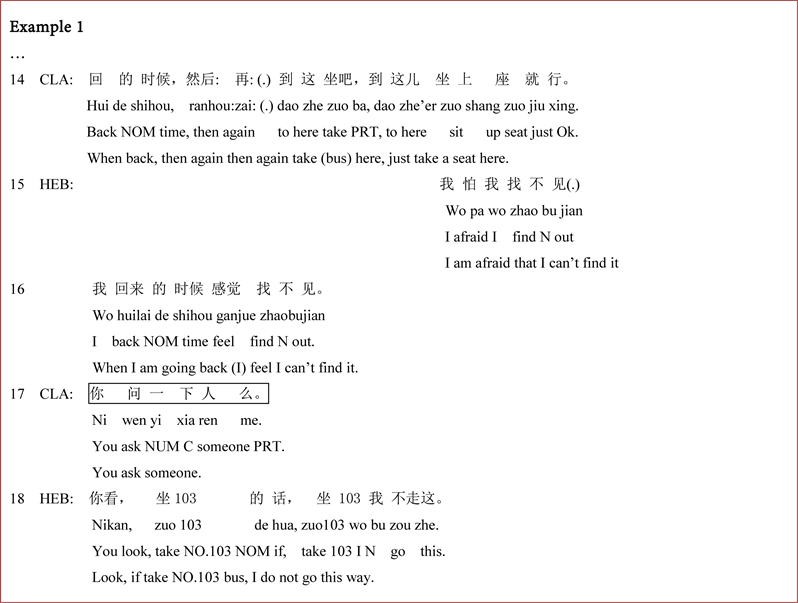
In this example Clare answered Hebe’s inquiry on how to take a bus to a restaurant mentioned in the previous talk and by the way Clare added to inform Hebe where to take a bus to go back at line 14. The occasioned topic was topicalized by Hebe in the following turn. Hebe showed her worry in finding the way back in the subsequent turn I am afraid… in the overlapping part and then after overlapping she reformulated it into when I am going back I feel…, which turns a worry in mind and in imagination into a more certain feeling, turns a potential problem into an explicit problem, intensifying the uncertainty in finding the way back.
Under this sequential environment constructed at line 15 - 16, an explicit problem is displayed by the advisee. Clare recognized the problem and gave a possible solution through an imperative on the phone before Hebe prepared to go back. Besides, no other possible solutions appeared yet before this imperative advice at line 17 as a kind of alleviation to the problem.
Sometimes when the problem is displayed by the advisee and the adviser also evaluates the problematic situation with the negative assessment or the affect-laden interjection such as “aiya” in Mandarin which projects something bad in the following turn.
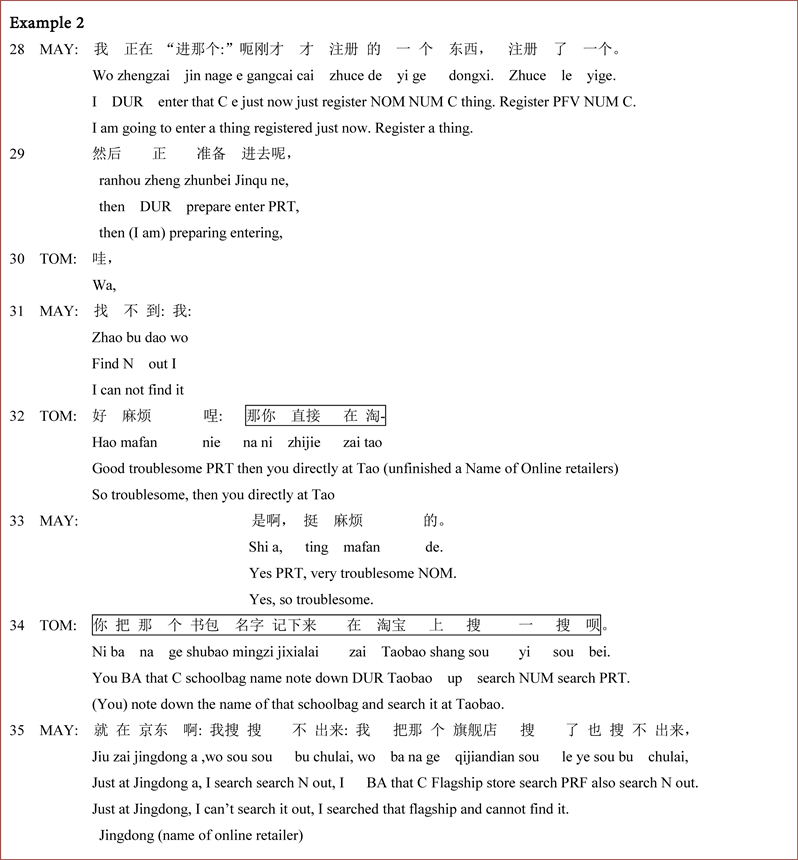
In this telephone conversation, May described the process she was searching online the discounted product she wanted to buy, and reported the problem she met on the spot. After the overlapping at line 30-31, May abandoned her turn, and Tom resumed his turn. The report of problematic situation occasioned the evaluation of the process as “troublesome” at line 32 from Tom, which demonstrates the Tom’s interpretation of her turn at line 28 - 29, 31 as a real problem, and the second TCU of the turn at line 32 began to offer a possible solution in order to help May out of the trouble. The advice was put forward in an imperative form to direct the other party to do something directly. The sequential environment for the advice is urgent, because the girl was searching online at the moment and the discounted product online has a time limit. The intersubjectivity is achieved through displaying an explicit problem by the advisee and recognizing the trouble by the adviser, which is the prerequisite and also the particular local sequential environment for the advice at line 32 and 34. In the both cases the imperatives alone constitute a turn in the conversation.
3.1.2. Explicit Problem Identified by the Adviser
Sometimes the problem is not demonstrated explicitly by the advisee by words; however the problem is noticed, perceived, identified and evaluated by the adviser as an overt problematic situation demanding advice.

In this example, Kate inquired Jenny about the examination in the prior turns and Jenny answered without any cough. Kate began a new turn with a turn-initial delay and an address term which prefaced a shift in the topic at line 43. This turn changed the topic to an inquiry into Jenny’s health condition. The yes/no question at line 43 come up to seek confirmation accompanied with evidentials because Kate perceived Jenny’s problem on the throat through Jenny’s hoarse voice during the call. After Jenny confirmed her problematic condition, the advice at line 46 is delivered instantly in an imperative format before any other possible solution mentioned. The intersubjectivity on an explicit problem is achieved by both parties before the advice is given.
Examples of this kind also justified that the advice giver has an orientation to formulate the advice in these two imperative forms in accordance with the evaluation on the explicitness and sometimes even severity of the problem in the specific interaction situation. Besides, what need to be noticed is that imperatives appear alone under this kind of sequential environment.
3.2. Sequential Environment of Declarative Typed Advice I Think…,I Tell You…, You Can…
In this part the interactional situation discussed refers to the following two kinds of sequential environment of advice: downgraded explicit problem and no problem. In this sequential environment three syntactic formats frequently are employed to do the advice-giving: I think that you…, I tell you that… and You can…. In our collected data, these three practices are often employed in the sequential environment which is not in parallel circumstances as that of the two imperatives analyzed in the previous part.
Generally the sequential environment of these practices evaluated by the advice giver is not an explicit problematic one with no possible solution. That is not to say the sequential environment for the initiation of advice is only determined by the advice giver alone, on the contrary, the sequential environment is constructed by both parties, the perception, recognition or evaluation by the adviser are all closely relevant to the prior information provided by the advisee.
3.2.1. Downgraded Explicit Problem
1) Explicit but downgraded problem
One sequential position for these three practices is that a problem is explicitly displayed by the advisee, but either the advisee displays it in an alleviated/downgraded way (evidence in the turn construction) and recognized by the adviser or the adviser evaluates and assesses it as neither a serious nor urgent problem, sometimes even not a problem.

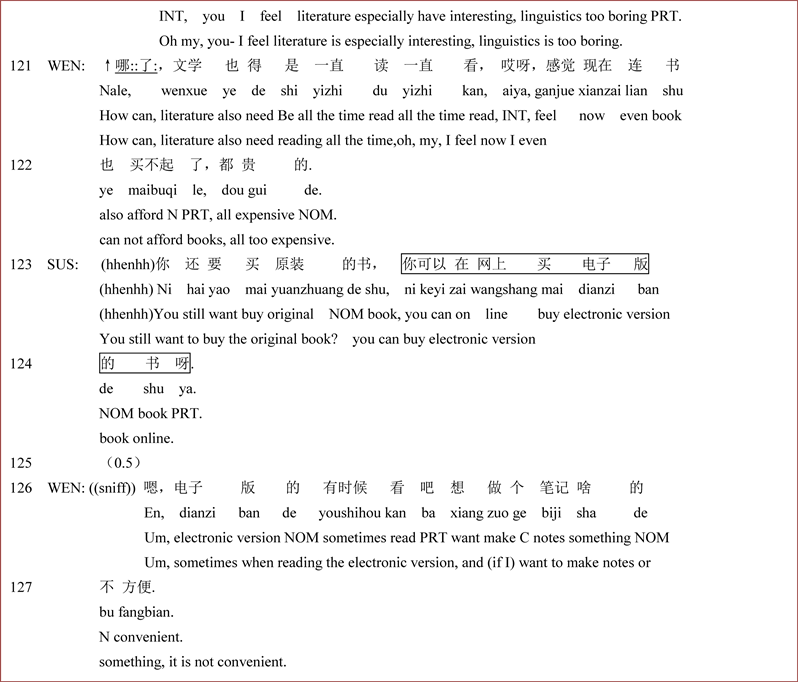
Susan and Wendy in this telephone conversation are postgraduates majored in linguistics and literature respectively. Susan’s assessment of two subjects at line 120 was responded with disagreement from Wendy on the painstaking reading in literature and the expensiveness of books at line 121 - 122. The subsequent turn at line 123 by Susan was constructed first by a reversed polarity question (Koshik, 1999) through which buying the book was topicalized. The reversed polarity question indicated that there is no necessity in buying the original books, which put the presupposition of the problem in the prior turn into question as well as cast a doubt on the severity of the problem, or even doubt on whether it counted as a problem. This first TCU at line 123 undermined the explicit problematic sequential environment formulated in the prior turn. Thus the advice in you can… form was formulated under this sequential position different from that in the 3.1 section. The advice given in Section 3.1 immediately follows an explicit problem or follows a congruent recognition of the explicit problem, that is two parties achieve intersubjectivity in determining the nature of the problem. However, in this example, the two parties display different evaluation on the same problem, and Susan the advice-giver downgraded the severity of the problem first and then formulated her advice in a you can… form.
The following is a similar example of this class.
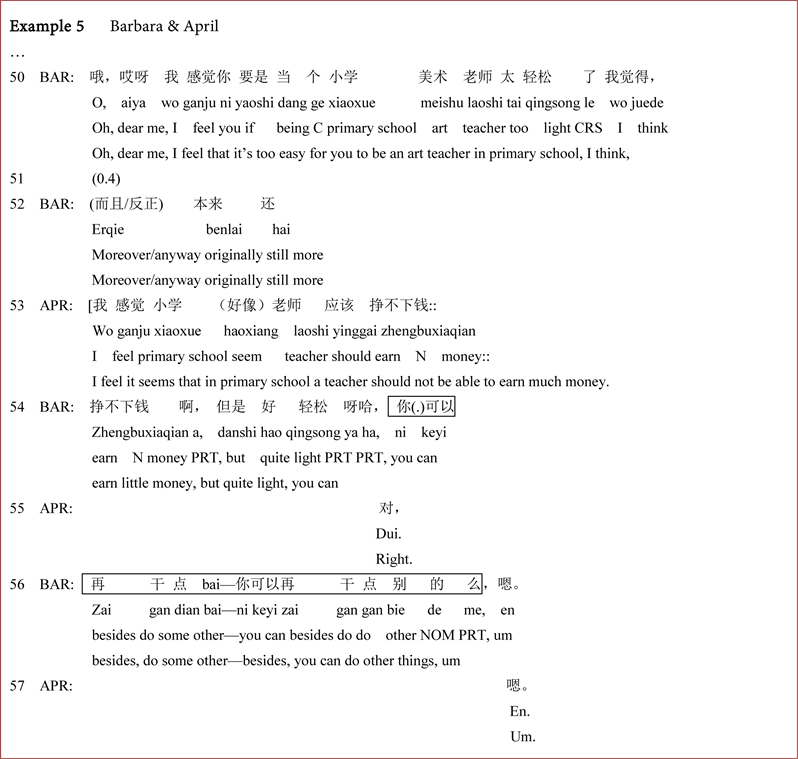
In this conversation April was going to attend a teacher-qualification examination reluctantly and Barbara gave a positive assessment at line 50 on a teaching career in a primary school. However, April showed her worry to be a teacher in a primary school and began her turn with “I feel” which downgraded the epistemic stance in what she is going to say, and then employed the lexical choice of the words seem and should adding the uncertainty in what she stated. It is where explicit problem lies. Although the problem was downgraded, advice was elicited in the next turn. In the subsequent turn, Barbara first acknowledged the disadvantages of the career, but downgraded the severity of the explicit problem in the prior turn by emphasizing the salient advantages of being a teacher and gave advice to the solve April’s worry. The advice is formulated in you can… form, which put less imposition on the recipient in a relatively softened and alleviated interactional situation.
2) Explicit Problem with a Possible Solution
The sequential environment in this part is that the problem is explicitly displayed coupled with a possible solution, however this possible solution is improper from the adviser’s perspective.
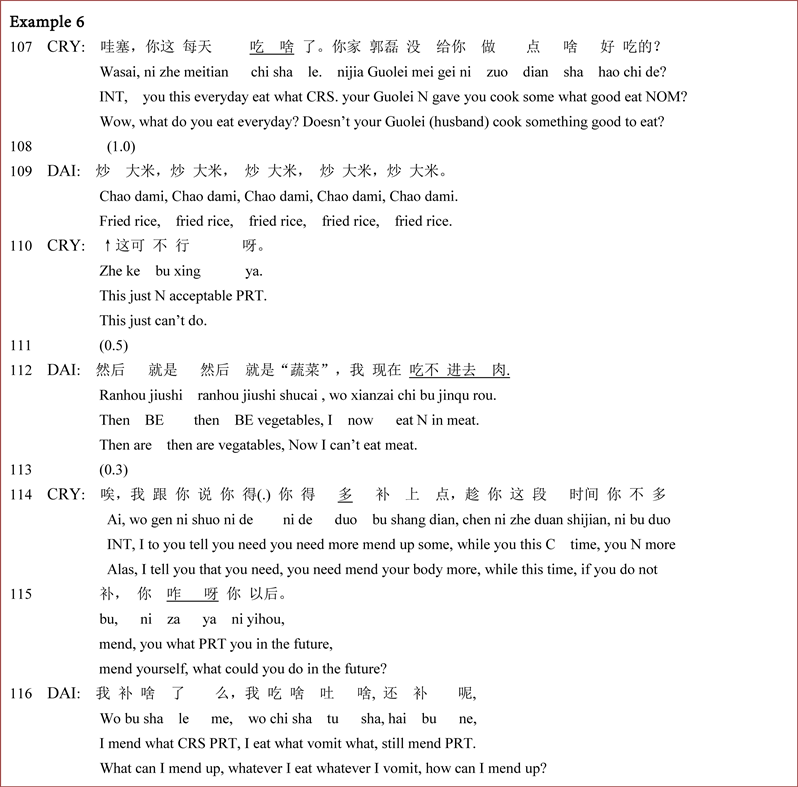
Daisy was pregnant and Crystal was inquiring her diet, from a more general question to a specific question at line 107, which was responded with repetition of “fired rice” to describe a monotonous diet.
Crystal
assessed this situation as problematic at line 110. Subsequently, Daisy added “vegetables” to modify the extreme case formulation (Pomerantz, 1986; Edwards, 2000) and accounted why only “vegetables” added. The severity of the problem has alleviated due to a possible solution “vegetables”, nevertheless, the problem still existed and turned into an alleviated one. Under this circumstance, the advice is delivered through an informing I tell you that you need... to benefit A’s health condition, which disguised the imposition on Daisy, nonetheless, it was recognized as a piece of advice and it was overtly resisted by the infeasibility of the suggested action.

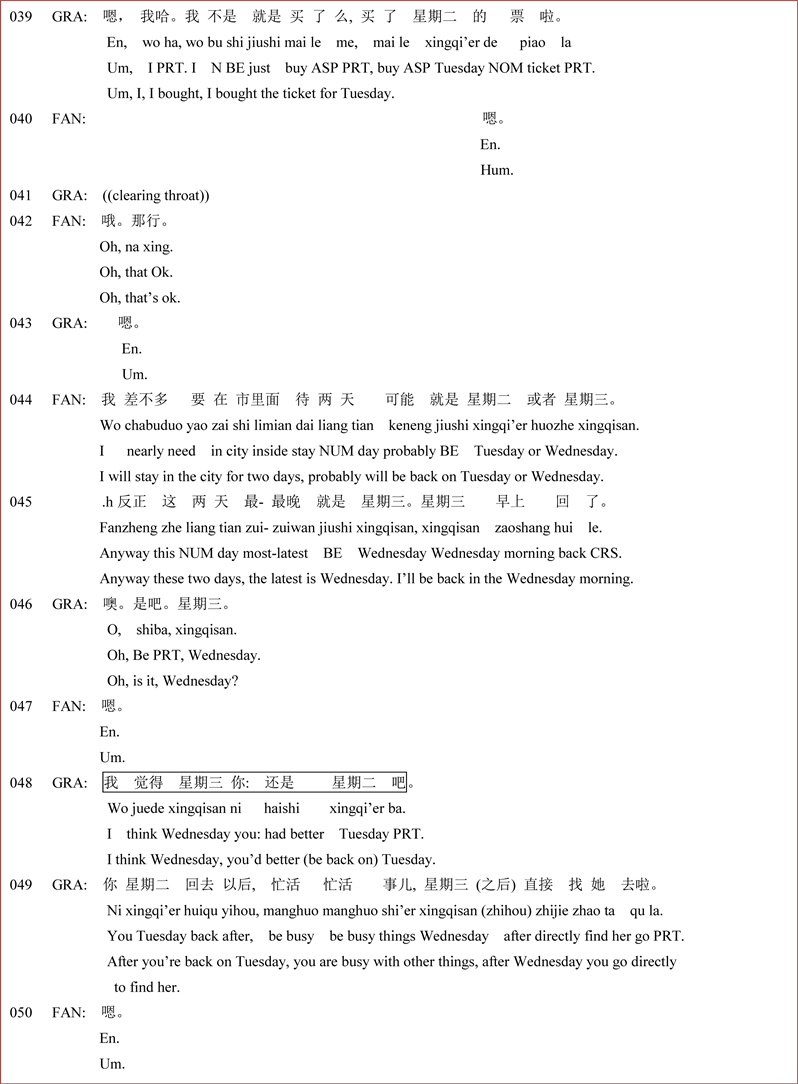
Fanny and Grace are classmates and the paper they collaboratively did was rejected by the teacher. They were talking about going back to school together to have a talk with the teacher. Fanny announced her decision to go back as soon as possible at line 36 and asked the date when Grace was back at line 38. After she knew Grace’s decision, Fanny reciprocally contributed her arrangement and demonstrated a possibility to go back on Tuesday or Wednesday, and added the latest possibility is Wednesday at line 44 - 45. As for the problematic situation Fanny has already had the possible solutions to go back on Wednesday at the latest, but this possible solution was evaluated by the adviser as not a better one, and the advice was put forward in a more mild way. The advice was first formulated as I think Wednesday you: however, the stretched you worked as a pivot to construct the turn into another trajectory of advice you’d better Tuesday, accompanying with an account to legitimate her advice and the original formulation with Wednesday was abandoned. When the explicit problem occurs with a possible solution, apparently the problem would be solved in one way or another, the advice put forward is only to offer another more proper way to solve the advisee’s problem.
3.2.2. No Problem Displayed and Identified
This sequential environment for these three practices refers to the interactional situation when no problem is displayed by the advisee and also no problem is identified by the adviser, which is the extreme case at one end of the gradient of the downgraded problem. However, the advice giver voluntarily initiates advice in order to benefit the advisee on a related thing touched off by the prior talk. Compared with the sequential environment in Section 3.1, no problem is displayed and identified, thus the sequential environment is not so demanding for a piece of advice as that of the imperatives. The piece of advice is put forward mainly on the advice giver’s epistemic status on the related things and little on the demand of the sequential environment.
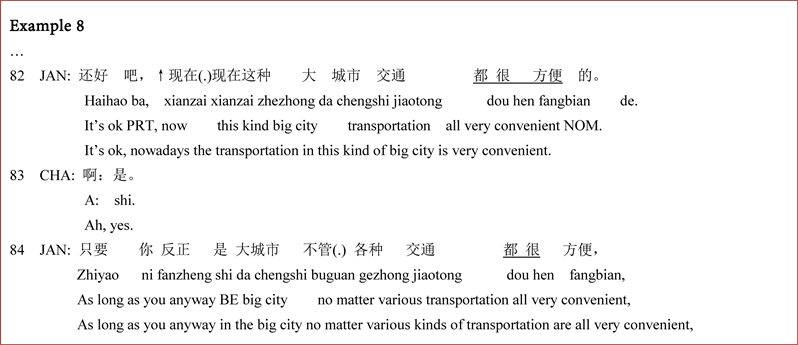
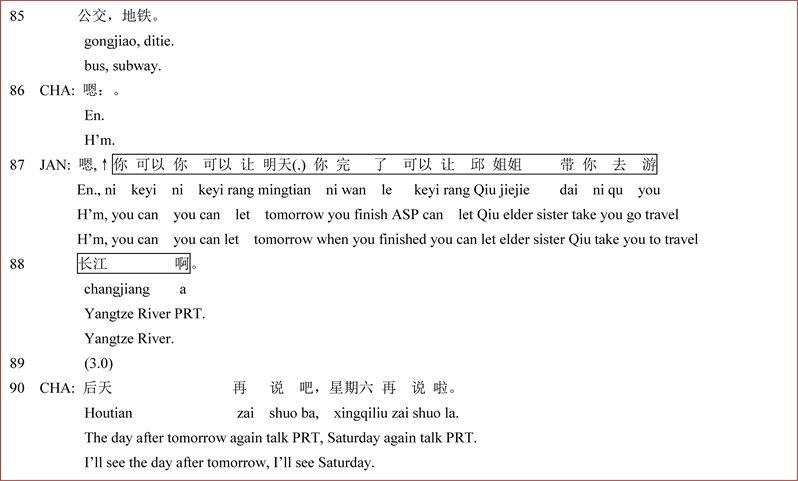
In this telephone conversation Charles said Wuhan is a long way from Wuchang in the previous talk, and Jane presented her disagreement accompanying with an account on the convenient transportation in big city at line 82, 84 - 85, which was responded with an agreement and a token of receipt at line 83 and 86 respectively. There was no indication in the preceding turns in this talk about the arrangement of Charles’ itinerary tomorrow, and Jane initiated a piece of advice at line 87 on this touched-off topic out of the convenience in the transportation mentioned in the prior turn. This piece of advice is based on her prior knowledge: the
Yangtze River
is worth visiting and Sister Qiu could be a good tour guide. The advice was formulated as you can…, which offered a great contingency for the recipient to reject than an imperative. This practice only offered a possible agenda for the recipient to enrich or better Charles’ journey in
Wuhan
.
Next example is one representative of a class of examples in this part. When the advisee expresses a wish or a positive assessment of something, adviser gives advice to benefit advisee. In the following example, the advice is affiliative to the action in the prior turn.


The following is another similar example, in which the advisee does not display any problem, and the adviser also does not identify anything as an explicit problem. Nevertheless, when the adviser disagrees or disaffiliates with the advisee, the advice is also put forward based on the adviser’s epistemic status on the matter and evaluation of the current situation of the advisee. Disagreement or the disaffiliation is implicative in the advice in these cases. The sequential environment for the advice is that the adviser evaluated the advisee’s situation is not a good or a correct one which also account for the disaffiliative nature of advice in this type of advices.
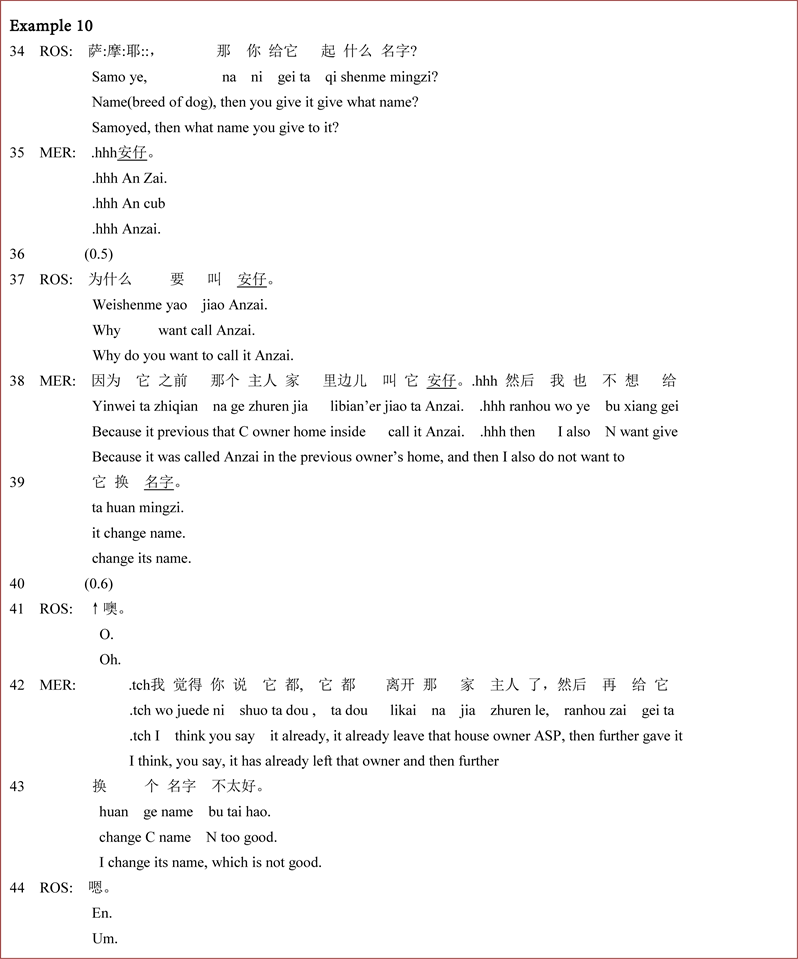
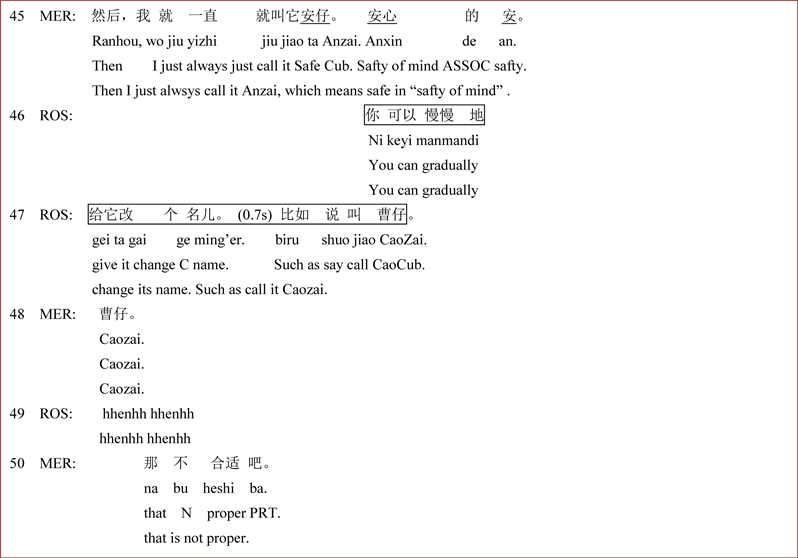
Rose and Merry were talking about the dog Merry recently got. Rose inquired the name of the dog and the account of the naming at line 34 and line 37 separately. Merry responded that the name was kept from the previous owner and accounted for not changing its name. The formulation of Merry’s turn did not display that keeping the prior name has any problem; on the contrary, it was good for the dog according to Merry’s account. Nevertheless, Rose still put forward a piece of advice in this sequential position for the sake of Merry based on Rose’s own knowledge in her epistemic territory “it is normative for a dog having a new name given by the new owner”. This syntactic pattern downgraded the imposition on Merry with a modal verb can, and was disaffiliative with Merry’s will and action obviously. The sequential environment is unfavorable to entitle Rose enough rights to let Merry change the dog’s name despite for Merry’s sake, in that there is no problem (or a probmatic situation with a convenient solution, to adopt the prior name) for the advisee and the advice is going to be disaffiliative. This case is border case between no problem and the problem with a possible solution. It hedges the border, but as for these three declarative-typed advice, the sequential environment takes on a gradient distribution, not a clear-cut or divided, discrete, separated thing.
The two parties in the conversation take an opposite stance on the naming. The adviser Rose is oriented to her own evaluation of the situation as problematic (not good or not correct) to put forward a piece of advice. However, because the advisee does not display any problem and the adviser also do not identify the thing as an explicit problem, the advice is only put forward as disaffiliative, which does not have the strong imposition as the imperatives.
Example 8, 9, 10 are all the cases when the advisee does not display an explicit problem and at the same time the adviser also does not identified an explicit problem. Nevertheless the nuanced differences still lies in the sequential environment of advice. In the example 10 the advice is disaffiliative to the prior turn, and in the example 9, the advice is affiliative to the prior turn, and in the example 8, the advice is on a touched-off topic, no overt affiliation or disaffiliation could be discussed. The sequential environment of these examples is on a gradient. One end of the gradient is no problem and the other end of the gradient is explicit problem with no solution.
The demanding degree of the advice in these examples:
Example 10 is a border case hovering over the “no problem” and “explicit problem with a possible solution”, in that a piece of disaffiliative advice displays that the adviser’s evaluation of the situation is not suitable, however the advisee already has a “possible solution” and does not regard the “problem” from adviser’s perspective as a problem. Example 10 blurred the border between the sequential environments in Section 3.2.1 and 3.2.2.
The sequential environment in Section 3.2, both downgraded explicit problem and no problem, is not so demanding for a piece of advice as that of the explicit problem with no solution.
4. Discussion
4.1. The Relation between Syntactic Forms of Advice and Their Sequential Environment
As is known to all, advice-giving is an other-attentive action, therefore, advice-giver is sensitive to the advisee’s situation no matter it is an explicit problem or not. According to the analysis of the sequential positions of these practices where the unsolicited advice is delivered, we found that they demonstrate distinctive sequential features from each other. The imperative formatted advice (you do X, do X) frequently are employed in the sequential environment when an explicit problem is displayed by the advisee or identified by the adviser and above all no solution has come up yet, that is, where a possible solution is urgently demanded. Imperative formatted advice seldom occurs alone at the sequential environment of downgraded problem or no problem in Section 3.2. The other three practices you can…, I think that you…, I tell you that…, which explicitly give advice are always employed when the sequential environment is a downgraded problematic one or no problem, seldom do they appear immediately after an explicit problem without any possible solution.
Distinguished from the institutional advice given by the nurses to the patients in Leppanen’s study (1998), the adviser has an orientation to be attentive to the interactional situation emerged in the interaction and the advice is put forward according to the adviser’s evaluations and assessment of the situation at that moment in the interaction. Therefore if the situation the advisee displayed is no problem, and also there is no explicit problem identified by the adviser, then the adviser sheerly put forward advice to benefit the advisee based on the adviser’s epistemic status. This kind of sequential environment per se do not call for advice, that is, the occurrence of advice is not as necessary as that of imperatives. If the interactional situation is a downgraded explicit problem, the sequential environment for the advice is obviously not as urgent as that of imperatives. The investigation further validates that syntactical forms that employed by the adviser is sensitive to their sequential environment, and this distributional pattern is closely related to the adviser’s orientation to the evaluation of the problematic situation in a specific sequential environment.
4.2. Deontic Rights under the Syntactic Forms
Deontic rights refer to the capacity of an individual to determine action (Stevanovic, 2018), which is used to describe the underlying local power existing in the social interaction. What we could see at surface is the adviser initiated an action to let the advisee do a suggested action in the future and what underneath is the adviser’s local power playing at the level of moment-by-moment unfolding of the social interaction.
Under the particular sequential environment of advice when the advisee in the interaction contributes something problematic or even of no problem, the adviser as the a listener is made immediate involvement in the interaction out of morality, however advice-giving is a delicate issue to deal with due to its nature and its agent to commit the action, and how much deontic rights the adviser is entitled to have has to be taken into consideration when the advice is formulated. The sensitivity reflected on the construction of a particular syntactic form of advice to the different sequential environment is a demonstration and display of sensitivity in adviser’s deontic rights under the different sequential environment.
As shown in Figure 1, sequential environment is crucial in the conversation analysis, which is an important element in constructing and invoking the speaker’s deontic rights and which also plays a dominant role in the construction of the syntactic forms the speaker is going to employ to deliver advice. In case the adviser is involved in a situation when the explicitly problematic situation is displayed, perceived or recognized, then more moral obligation and more deontic rights are invoked to help the advisee. By contrast, in case when the advisee displays no problem or the problem is downgraded, less moral obligation and less deontic rights are invoked in the interaction.
![]()
Figure 1. Triangle relations among the syntactic form, sequential environment and deontic rights.
Syntactic form of advice is a display of the underlying deontic rights in the interaction. Advice in the two imperative formats in its distinctive sequential environment displays the high entitlement of the advice-giver with more deontic rights to get the advisee to do the suggested action, in contrast, advice in the other three formats employed in a milder problematic situation demonstrates the relative low entitlement of the advice-giver with less deontic rights to get the advisee to do something in the future. For example: the modal verb can leaves the contingency on the advisee to do the suggested action; I think downgrades the deontic rights into a personal opinion, which is up to the advisee to decide whether or not to take the suggested action; I tell you also takes a weak deontic stance to frame the advice into an informing, mitigating the imposition on the advicee to do the suggested action. These three syntactic formats in nature have less imposition on the advisee to do something than the imperatives, which is also in accordance with the deontic rights distribution in advice-giving sequential environment.
The sequential environment is constructed turn-by-turn by the two parties in the interaction. Sometimes the intersubjectivity is achieved, and there is congruence in the evaluation and assessment of the problem from the adviser and the advisee, that is, what the advisee displays is also perceived or recognized by the adviser to almost the same extent. However, sometimes when the intersubjectivity is not achieved, the adviser is oriented to his/her own knowledge to made the evaluation of situation and put forward the advice mainly according to his/her epistemic basis, which is also the basis of his deontic right (Stevanovic & Peräkylä, 2012).
As far as unsolicited advice in this paper concerned, the interaction most occur in the daily mundane conversation between peers, classmates, family members, colleagues, the identity and other social variants is not always the dominant element in these advice-givings. What is more important is the local power in the step-by-step unfolding of the interaction, the deontic right. It is greatly influenced by the sequential environment and the advice-giver’s epistemic status in these mundane interactions.
4.3. Deviate Cases Analysis
As usual CA research steps, our research went over the first step of CA analysis “the inductive search for regularity” (Heritage, 1988) and we established a pattern with the most typical cases. Then we come to the second step to conduct the deviant cases analysis. What deviant cases could indicate?
The deviate cases are found in our study. There are cases when the practices do X and you do X are employed to deliver advice in the sequential environment of downgraded problem or no problem mentioned in Section 3.2.
Advice in you do X format in the following example is put forward after a possible solution had appeared. Nevertheless, the advice is still put forward in an imperative form accompanied with an account.

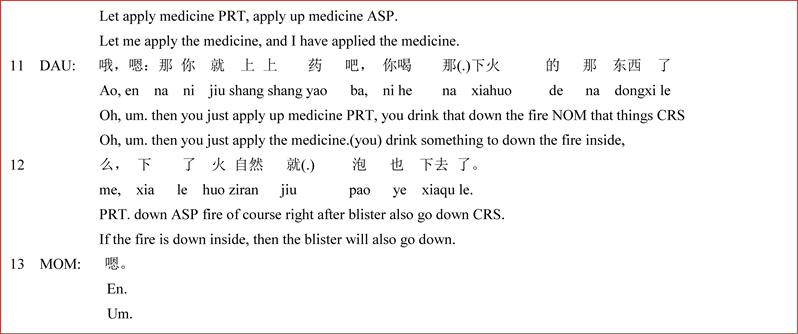
The daughter’s declarative question at line 1 was answered by mom’s account for home. The non-type-conformed answer (Raymond, 2000) touched off an inquiry initiated by the adult daughter which at the same time displayed her inference on the severity of the toothache. The daughter’s subsequent inquiry at line 6 and line 9 on the treatment condition demonstrated that her mother had already treated by the doctor. The first sentential TCU at 11 indicated the daughter’s agreement of the doctor’s treatment. In this example, the problem is mother’s toothache and the possible solution by the doctor is proper and agreed by the daughter.
According to the regularity we just found, it is not the normative sequential position for an imperative You drink something… to deliver advice because there was already a possible solution to the problem, moreover, the possible solution was given by the dentist, which would be the proper solution. Although the effect of the medicine may not work immediately, the severity of the problem has been downgraded. However, a piece of advice was put forward in an imperative format and the causal relationship between the imperative and the prospective results was emphasized in the account immediately following the advice.
When the occurrence of the advice in imperatives is not a normative phenomenon, account is needed. The account here downgrades the deontic rights in imperatives and also legitimates an imperative employed in this sequential position. The more deontic rights the adviser is entitled to give a piece of advice, the less the adviser’s need to account for his/her action of advice-delivery. Without account, the imperative alone to do the advice may take a risk of being unaccountable in this sequential position, and the imperative of advice may turn into an order, a command or an instruction.
In the next example, no explicit problem is displayed by the advisee, but an imperative format advice is delivered. In this situation, accounts are accompanying with the advice in an imperative form to bolster the viability of the advice in this sequential environment (Waring, 2007).
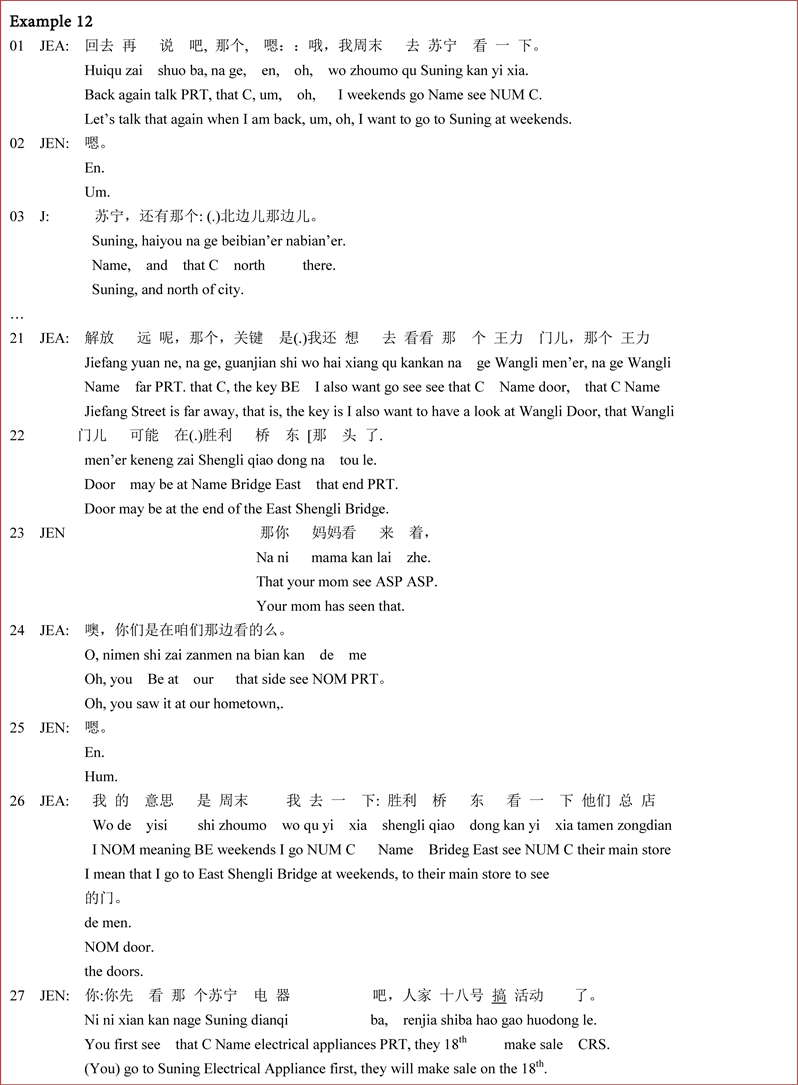
Jean and Jennifer are sisters. Jean lives in the city and Jennifer lives with their mother in the hometown. Jean was going to buy some electrical appliances and security door for the family and wanted to do some preliminary survey in the city at weekends. Jean asserted her decision “to go to Suning” and “North” at line 1 and line 3, and Jennifer initiated a side sequence to discuss with Jennifer about the specific location of Suning. After this side sequence, Jean reasserted her plan to go to the door mainstore in the North as well at weekends to do the survey of the door. No explicit problem displayed by Jean. Jennifer informed Jean the fact that their mom has already done the survey on security doors which indicated unnecessity for Jean going to the door shop, serving as an account before the advice to identify the potential problem (Waring, 2007). Jean undermined the rationality of this account by claiming the fact that mom did the survey in the hometown rather than in the city, which validated the necessity in Jean’s action.
The problem is not explicitly displayed or stated all through in this case. The accompanied account after the advice downgrades the Jennifer’s deontic rights in advice delivery and deontic authority in imperatives (Stevanovic & Peräkylä, 2012) to bolster the viability of the advice (Waring, 2007).
Compared with the typical advice in imperatives, the imperatives in Section 3.1 could do the advice alone registering a kind of deontic rights which need not provide any account for her initiation of the advice-giving. The imperatives in the examples like the above ones in Section 4.3. When they occur in a milder problematic situation, accounts are accompanied to downgrade deontic rights in the advice in imperative, and to legitimate its occurrence in this kind of sequential environment.
If the imperatives appear in this kind of sequential environment without any account, there is a risk that the advice is interpreted into a command or an order, which leaves no contingency for the recipient to refuse the action, which is against the action ascription and action formation of advice in nature (Levinson, 2013). The deviant cases are a strong evidence to prove the regularities of the sequentially-specific practices of advice: if the imperative-typed advice appears at the sequential environment of the declarative-typed advice, imperative alone is not a piece of advice in the interaction.
In sum, though the inductive research of the typical advice in imperatives and the declaratives and then a research on the deviate cases, we conclude that different syntactic formats employed to deliver advice displays a difference distribution in their sequential environment, which is closely related to the speaker’s orientation to deontic rights to give advice on a particular sequential position. Generally, advice in imperative formats like you do X and do X displays relatively more deontic rights to let the advisee do the suggested action compared with the rest other three formats. The deviate cases we found only in imperatives also justified the regularity. When the advice in imperative occurs in a non-normative sequential environment for imperatives, then account is accompanied to downgrade the deontic rights and to legitimate the occurrence of imperatives in a certain sequential environment.
5. Conclusion
The advice is invoked to benefit the advisee; therefore it is a pro-social altruistic action per se to maintain the social solidarity and social cooperation. Apart from this feature, advice-giving as another-attentive action also has a close relation with deontics. The core feature of the advice-giving is to get the advisee to do something, which is also where deontic rights lies. We investigated the sequential environment which is one of the constitutive elements to entitle the adviser the deontic right to give a piece of unsolicited advice (other constitutive elements including epistemic basis etc.) and concluded the distributional features of two kinds of different syntactical forms also display different deontic rights in giving advice.
This study only focuses on the distributional relationship of the syntactical formats and their sequential features in the unsolicited advice, and further investigation can be conducted on the solicited advice, in that, in the solicited condition, the adviser is already put in a position of deontic authority, which may take on distinctive features in giving advice. Besides, since the syntax is the research object in this paper, we take the other three practices as a whole to do the comparison with the two imperative practices. Further study could be conducted on the more specific practices of advice-giving and multimodal analysis of the advice-giving in the interaction.
This study enriches the grammar of spoken Chinese when doing the advice-giving and provides a basis study for the comparative studies of advice-giving in different languages. Moreover, this study could also provide a new perspective of further research on the other practices of advice-giving, such as my side telling, interrogative typed advice etc. in Mandarin daily conversation. Besides, the study of advice in mundane conversation also provides a foundation for the further study of advice in the institutional talk, such as conversation in the consultation, in the hospital, in the helpline etc. The regularity we found in the research also has practical significance in guiding people to employ the proper syntactic form to do the advice-giving in the daily conversation so as to create a harmonious personal relationship.
Note
This research is a part of a projection “A conversational analysis of suggestion sequence in daily talk-in-interaction” in the “Thirteenth Five-Year” Planning Projects in 2016 sponsored by the Institute of Education Sciences, Shanxi province, China (Grant No. GH-16174). It is also funded by Research Project Supported by Shanxi Scholarship Council of China (Project Number: 2016-016).
Abbreviations
NOM = nominalizer (de)
N = negator
PRT = particle
C = classifier
ASSOC = associative (-de)
ASP = aspectual marker
BA = ba-construction
BE = be (verb) (shi)
NUM = Number
PFV = perfective aspect marker
CRS = currently relevant state (-le)
CSC = complex stative construction (-de)
INT = interjection
DUR = durative aspect (one kind of ASP)